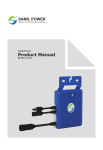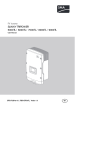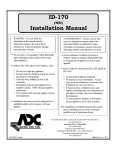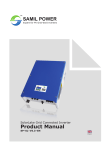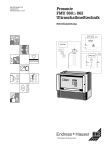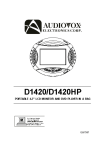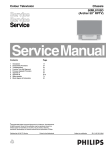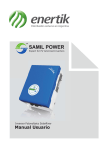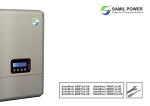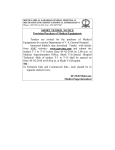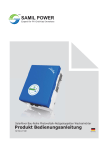Download 8 Troubleshooting
Transcript
TM SAMIL POWER Expert for PV Grid-tied Inverters SolarRiver 7000/8000/9000/10000TL-US USER MANUAL SP-SR7-10-US-V1 –EN Copyright Declaration Copyright @ 2011 SamilPower Co., LTD. All rights reserved. No part of this document may be reproduced, stored in a retrieval system, or transmitted, in any form or by ay means, electronic, mechanical, photographic, magnetic or otherwise, without the prior written permission of Samil Power Co., LTD. Samil Power Co., LTD makes no representation, express or implied, with respect to this documentation or any of the equipment and/or software it may describe, including(with no limitation) a n y i m p l i e d warranties of utility, merchantability, or fitness for any particular purpose. All such warranties a r e expressly disclaimed. Neither Samil Power Co., LTD nor its distributors or dealers shall be li a b l e f o r any indirect, incidental, or consequential damages under any circumstances.(The exclusion of implied warranties may not apply in all cases under some statutes, and thus the above exclusion may not apply.) Specifications are subject to change without notice. Every attempt has b e e n m a d e t o m a k e t h i s document complete, accurate and up-to-date. Readers are cautioned, however, that Samil Power Co., LTD reserves the right to make changes without notice and shall not be responsible for any damages, including indirect, incidental or consequential damages, caused by reliance on the materical presented, including, but not limited to, omissions, typographical errors, arithmetical errors or listing errors in the content materical. All trademarks are recognized even if these are not marker separately. Missing designations do not mean that a product or brand is not a registered trademark. Samil Power Co., LTD Address: No.66 Taihangshan Road, Suyu Economic Development Zone, SuQian City, Jiangsu Provience, P.R.China 223800 E-mail: [email protected]. 01 Important Safety Instructions Save these instructions This manual contains important instructions for SolarRiver-US inverter, that must be followed during installation and maintenance of the inverter. The SolarRiver-US is designed and tested according to international safety requirements, but as with all electrical and electronic equipment, certain precautions must be observed when installing and/or operating the SolarRiver-US. To reduce the risk of personal injury and to ensure the safe installation and operation of the SolarRiver-US. You must carefully read and follow all instrucions cautons and warning in this user manual. Warning in this document This manual provides safety operation information and uses the symbol in order to ensure personal and property security and use the inverter efficiently when operating the inverter. You must understand and absolute these emphasize information to avoid the personal injury and property loss. Please read the following symbols which used in this manual carefully. Danger Danger indicates a hazardous situations which, if not avoided, will result in death or serious injury. Warning Warning indicates a hazardous situations which, if not avoided, could result in death or serious injury. Caution Caution indicates a hazardous situations which, if not avoided, could result in minor or moderate injury. Notice Notice is used to address practices not related to personal injury. Other symbols in this document In addition to the safety and hazard symbols described in the previous pages, the following symbols are also used in this user manual. Remark: These symbols note that call attention to supplementary information that you must know and use to ensure optional operation of the system. Marking on this product The following symbols are used as product marking with the following means. Symbol Explanation Warning regarding dangerous voltage The product works with high voltages. All work on the product must only be performed as described in its documentation. Electric arc hazards The product has large electrical potential differences between its conductors. Arc flashes can occur through air when high-voltage current flows. Do not work on the product during operation. 02 Symbol Explanation Beware of hot surface The product has can become hot during operation. Do not touch the product during operation. Observe the operating instructions Read the product’s documentation before working on it. Follow all safety precautions and instructions as described in the documentation. AC current DC current Earth Ground UL 1714 is the standard applied by Canadian Standards Association to the SolarRiver-US to certify that it meets the requirements of National Electrical Code® and functonality necessary to rensure compatible operation when power generation is connected to the utility grid. General Warnings General Warnings All electrical installations must be done in accordance with local and National Electrical Code® ANSI/NFPA 70. For installation in Canada the installations must be done in accordance with applicable Canadian standards. The SolarRiver-US contains no user-serviceable parts except for the fans on the buttom of the enclose and the filters behind the fans. For all repair and maintenance, always return the unit to an authorized Samil Power Service Center. Before installing or using the SolarRiver-US, read all of the instructions, cautions and warnings in the user manual. Before connecting the SolarRiver-US to the electrical utility grid, contact the local utility company. This connection must be made only by qualified personnel. Warning of the SolarRiver-US must be made by qualified personnel only. Warning Risk of electric shock and fire. Use only with PV modules with a maximum system voltage of rating of 600V or lower. 03 Note 1 Notes on this manual ......................................................................................................... 6 1.1 1.2 1.3 1.4 1.5 Validity................................................................................................................................ Target group ....................................................................................................................... Storage of the documentation................................................................................................ Additional information ........................................................................................................ Nomenclature ..................................................................................................................... 6 6 6 6 6 2 Safety .................................................................................................................................... 6 2.1 Appropriate useage................................................................................................................ 6 2.2 Safety instructions................................................................................................................. 8 2.3 Installation overview ............................................................................................................. 8 3 Unpacking and inspection..................................................................................................... 9 3.1 Scope of delivery................................................................................................................... 9 3.2 Product label......................................................................................................................... 10 4 Mounting ........................................................................................................................... 10 4.1 Safety ................................................................................................................................ 10 4.2 Package inspection ............................................................................................................... 10 4.3 Installation precaution.............................................................................................................. 11 4.4 Preparation ............................................................................................................................. 12 4.5 Installation steps................................................................................................................... 13 5 Electrical connection .......................................................................................................... 15 5.1 General electrical connection procedure of SolarRiver-US inverter .............................................. 16 5.2 Opening wiring cover of SolarRiver-US inverter ........................................................................ 18 5.3 AC wiring................................................................................................................................. 18 5.3.1 AC voltage configuration ............................................................................................... 19 5.3.2 AC wiring procedure...................................................................................................... 19 5.4 DC wiring................................................................................................................................ 20 5.4.1 Configuring the DC input channel ....................................................................................... 21 5.4.2 DC wiring procedure........................................................................................................ 21 5.4.3 Connection to a single PV array (SolarRiver-US).................................................................. 22 5.4.4 Parallel connection to 2 PV arrays (SolarRiver-US)............................................................... 22 5.4.5 Two MPPTS connection to 2 PV arrays or 5 PV arrays (SolarRiver-US)).................................... 23 5.5 Communication wiring .......................................................................................................... 23 5.6 WIFI installation.................................................................................................................... 24 6 Commissioning .................................................................................................................. 27 7 Display and messages ....................................................................................................... 28 7.1 LED indicators ..................................................................................................................... 28 7.2 Available Data .................................................................................................................... 29 7.2.1 Real-time operational data......................................................................................... . . . . 29 7.2.2 Internally logged data.................................................................................................... 29 7.2 LCD display and operation .................................................................................................... 29 7.3.1 Display upon start-up..................................................................................................... 29 04 7.3.2 Default Menu ............................................................................................................ 30 7.3.3 Main Menu ................................................................................................................. 31 7.3.4 Running Menu............................................................................................................ 31 7.3.5 Setting Menu ............................................................................................................. 33 7.3.6 Event........................................................................................................................ 37 7.3.7 Service ...................................................................................................................... 37 8 Troubleshooting ............................................................................................................... 38 8.1 General .............................................................................................................................. 38 8.2 Messages and Error Codes ................................................................................................... 38 9 Maintenance ..................................................................................................................... 40 9.1 Cleaning the fans ................................................................................................................ 40 9.2 Checking the DC Disconnect ................................................................................................. 40 10 Garantie .......................................................................................................................... 41 10.1 FCC compliance information ............................................................................................... 41 10.2 SolarRiver-US wiring diagrams ............................................................................................ 41 10.2.1 SolarRiver-US without DC disconnect .......................................................................... 42 10.2.2 SolarRiver-US with DC disconnect .............................................................................. 42 10.3 Input data......................................................................................................................... 42 10.4 Output data........................................................................................................................ 43 10.5 Efficient............................................................................................................................ 43 10.6 General data...................................................................................................................... 43 10.7 Trip limits/trip times........................................................................................................... 44 11 Contact .............................................................................................................................. 44 05 Notes on this manual & Safety 1 Notes on this manual 1.1 Validity This manual describes the assembly, installation, commissioning and maintenance of the following Samil Power inverters: SolarRiver 7000TL-US SolarRiver 8000TL-US SolarRiver 9000TL-US SolarRiver 10000TL-US This manual does not cover any details concerning equipment connected to the SolarRiver-US(e.g. PV modules). Information concerning the connected equipment is available from the manufacture of the equipment. 1.2 Target group This manual is for qualified personnel. Qualified personnel have received training and have demonstrated skills and knowledge in the construction and operation of this device. Qualified personnel are trained to deal with the dangers and hazards involved in installing electric devices. 1.3 Storage of the documentation Keep all SolarRiver-US manuals in a convenient place for future reference. 1.4Additional information You will find further information on special topics in the download area at www.samilpower.com. 1.5 Nomenclature In this document Samil Power Co., LTD is referred to the following as Samil Power. 2 Safety 2.1 Appropriate useage The SolarRiver-US is a DC to AC grid-tied utility interactive inverter for use with photovoltaic (PV). In general, the SolarRiver-US takes power from a DC source (PV modules) and converts it to AC power for the utility grid. This power is delivered first to local loads (household appliance, lights, motor loads, etc.), with any excess power fed to the utility. The power consumed by the local loads reduces the power needed from the utility. Excess power may actually spin the utility meter backwards depending on the type of meter in you system. This power may also be recorded as power credits by the utility company depending on the interconnection agreement. An example of basic system components is shown in figure below. Principle of a PV plant with a SolarRiver-US: 06 Safety Position Description A PV array B SolarRiver-US with/without DC Disconnect C Local loads D Energy meter E Utility Grid Remark: Policies vary from one utility company to another. Consult with a representative of the local utility company before designing and installing a PV system. Anti-Islanding protection Islanding is a condition that can occur if the utility grid is disconnected while the SolarRiver-US is operating and the remaining load is resonant at 60 HZ and matches the output of the SolarRiver-US perfectly. This condition is highly unlikely and had never been witnessed outside of a controlled laboratory. Nevertheless, the SolarRiver-US incorporates an advanced active islanding protection algorithm to ensure that the system will not export power into a balanced 60 HZ resonant load while the utility is disconnected. The SolarRiver-US periodically injects both leading and lagging reactive current into the utility grid. This method has been proven by Canadian Standards Association to effectively destabilize and disconnect from a balanced island condition. The SolarRiver-US is equipped with a ground isolation fault detection device. If a ground isolation fault is detected, the SolarRiver-US will not run and display the fault function on the user interface display. Once the ground fault is located and corrected, the ground fault error will need to be manually cleared and the inverter will then resume normal operation automatically. PV series fusing Series fusing may be required depending on the type of PV module used in the system. See NEC 690.9. Remark: For SolarRiver -US, the AC fuses are optional installed in the unit. When not provided with the unit, it should be provided at end installation. DC disconnect The DC disconnect is optional installed in the unit. If the models is not provided with DC disconnect, they should be provided externally. Operating temperature The SolarRiver-US has been designed to maintain full power output at ambient temperatures as high as +113°F (+45°C). Fan cooling allows this level of output power to be achieved even in enclosed spaces. The SolarRiver-US will continue to operate well between +113°F(+45°C) and +140°F(+60°C) and de-rates as needed to maintain a safe internal component temperature. Warning Continuous storage time must be less than 3 months below -13°F(-25°C). Interconnection code compliance The SolarRiver-US has been tested and listed by Canadian Standards Association to meet the requirements of UL 1741 Static Inverters and Charge Controller for use in Photovoltaic Power Systems and IEEE 1547 Standard for Interconnecting Distributed Resources with Electric Power System. The SolarRiver-US is also listed under UL 1741 for Nationally Recognized Testing Laboratory. UL 1741 is the standard applied by Canadian Standards Association to the SolarRiver-US to certify that it meets the requirements of the NEC and functionality necessary to ensure compatible operation when power generation is connected to the utility grid. Remark: Contact the local utility and/or the authority having jurisdiction prior to connecting the SolarRiver-US to the utility grid. FCC compliance The SolarRiver-US has been tested and shown to confirm with all FCC Part 15 B EMI/EMC emissions regulations. 07 Safety 2.2 Safety instructions Danger High voltages are present in the SolarRiver-US during the operation. Death or seriously injury due to electric shock. All work on the SolarRiver-US must only be carried out by qualified personnel. Warning The SolarRiver-US can become hot during operation. Risk of burns: Do not touch enclosure during operation; Only touch panel during operation. Warning When the SolarRiver-US is running, connect it to the ground. 2.3 Installation overview This section provides a brief overview of the installation process of SolarRiver-US. Section 3: Unpacking and inspection This section provides instructions and information for unpacking the SolarRiver-US and inspecting it for shipping damage. Section 4: Mounting This section includes guidelines to help you select the best mounting location, suggestions to ensure optimum performance, cautions and warnings that you should follow to avoid injury and/or equipment damage and step-by-step instructions for mounting the SolarRiver-US inverter. Section 5: Electrical connection This section includes configuration of AC voltage and DC input channel, guidelines for selecting the correct wire size, cautions and warnings that you should follow to avoid injury and/or equipment damage and step-by-step instructions for wiring the SolarRiver-US to a PV array, household electrical circuits and the utility grid. Procedures are also included for connecting optional data-communication cables. Section 6: Commissioning Commissioning involves applying DC input power to the SolarRiver-US, observing the LED and LCD indicators on the front cover, and resolving any problems that occur. Section 7: Displays and messages This section provides messages for displays, settings and faults during installation and operation. Section 8: Troubleshooting This section provides troubleshooting tips and procedures for resolving problems that may occur during installation and operation. Section 9: Maintenance This section includes maintenance and cleaning of the SolarRiver-US and cautions and warnings you should follow to avoid injury and/or equipment damage. Section 10: Technical data This section includes technical data for the SolarRiver-US, connection diagrams and torque specifications for the connection of cables and the screws of the SolarRiver-US. 08 Unpacking and inspection 3 Unpacking and inspection All SolarRiver-US inverters are thoroughly tested and inspected before they are packed and shipped. Although they are shipped in sturdy, recyclable packaging, damage can still occur during shipping. It is important to carefully inspect the shipping container prior to beginning the installation. If any external damage to the packaging makes you suspect the inverter itself could be damage, or if you find that the inverter is damaged after unpacking it, report the damage immediately to your Samil Power dealer and to the shipping company that delivered the SolarRiver-US. If it becomes necessary to return the SolarRiver-US, use the original packaging in which it was delivered. Caution Failing of the SolarRiver-US may cause injuires. Crushing of body parts will result in injuries. Take the weight of the SolarRiver-US of 101.3 lbs.(46 kg) into account when mounting. If you need assistance with a damaged SolarRiver-US, contact your Samil Power dealer or Samil Power. Contact information is provided in section “Contact”. 3.1 Scope of delivery A B E F TM SAMIL POWER D G H Samil Power Co., Ltd. TM Expert for PV Grid-tied Inverters SAMIL POWER C Warranty Card Expert for PV Grid-tied Inverters Customer Information ☆Name: ☆Address: City: State: Tel: Fax: Zip Code: E-mail: System Information System Commissioning Date: ☆Model of Products: No. of Products Used: ☆Date of Bill of Lading: ☆No. of Fault Products: ☆Series No. of Fault Products: Fault Time: ☆Fault Messages: ☆Brief Fault Description and Photos: Installation Information ☆Modules Used: ☆Modules Per String: ☆No. of Strings: ☆Installation Company: Installer Name: SolarRiver 7000/8000/9000/10000TL-US USER MANUAL For the information on our warranty terms and conditions, please see our website: www.samilpower.com. Fields marked with ☆ are required information. SP-SR7-10-US-V1 –EN ☆Customer Signature: ☆Date: All rights reserved by Samil Power. This information is subject to changes without notice. T: +86 (0)510 83593131; F: +86 (0)51081819678 E-mail:[email protected]; www.samilpower.com; Add: No.66 Taihangshan Rd. Suyu Economic Development Zone, Suqian,Jiangsu, 223800 P.R.China Position Number Description A 1 SolarRiver-US series inverter B 1 Bracket C 1 Screw bag D 1 Packing list E 1 Product manual F 1 Warranty card G 1 Quality certificate H 1 WIFI Model Remark Screw bag containing: Nr.4 6*40 screws; Nr.4 PEB8-38 wall plugs; Nr.2 6*10 screw. 09 Unpacking and inspection & Mounting 3.2 Product label The product label provides basic information of the inverter. Pay special attention to the type of inverter and other specifications. 4 Mounting 4.1 Safety Warning The electrical installation of the SolarRiver-US inverter must be performed in accordance with the electrical standards prescribed by the local regulations and by the National Electric Code (ANSI/NFPA 70 standard). Warning The connection of a SolarRiver-US inverter to the electrical distribution grid must be performed only receiving authorization from the utility that operates the grid. Warning Before installation and maintenance, AC and DC side does not carry electricity. If DC side is just disconnected, capacitance still contains electricity, so please wait for at least 5 minutes to ensure the capacitors completely release the energy and inverter is not electrified. Warning Inverters must be installed by qualified person. 4.2 Package inspection Note The distributor delivered your SolarRiver-US inverter to the carrier safely packaged and in perfect condition. Upon acceptance of the package, the carrier assumes responsibility for its safe delivery. In spite of careful handing, transportation damage to the package or its contents is always a possibility. The customer is encouraged to perform the following checks: Inspect the shipping box for apparent damage, such as holes, cracking, or any other sign of possible damage to its contents. Describe any damage or shortage on the receiving documents and have the carrier sign his/her full name. Open the shipping box and inspect the contents for internal damage. While unpacking, be careful not to discard any equipment, parts or manuals. If any damage is detected, call the delivering carrier to determine the appropriate action. Save all shipping material in the event that the carrier sends an inspector to verify damage! • • • 10 Mounting • If the inspection reveals damage to the inverter, contact your supplier or authorized distributor. They will determine if the equipment should be returned for repair. They will also provide instructions on how to get the equipment repaired. • It is the customer’s responsibility to file a claim with the carrier. Failure to file a claim with the carrier may void all warranty service rights for any damage. • Save the SolarRiver-US series inverter’s original shipping package in the event that you should ever need to return the inverter for repair. 4.3 Installation precaution � Installation site should be selected based on the following considerations: The ambient temperature is in the range of tolerable ambient temperature (-25℃ to +60℃, -13℉ to +140℉); Lower than the altitude of about 2000m above sea level; Unable to be damage by sea water; Don’t be exposed to steam, vapor, or water; Far away from corrosive gas or liquid (for example, locations where chemicals are processed or the location where feed lots of poultry). Far away from the television antenna or antenna cable; Choose a location that allows unobstructed airflow around the inverter; Allow sufficient room around the inverter to enable easy installation and removal from the mounting surface. • • • • • • • • Warning Not installing the inverter in the place mentioned above may cause the malfunction of the system. Samil Power will not compensate the fault caused by the above situation. The following figures show the recommended installation of the inverter: Minimum clearance for SolarRiver-US series inverter Arrangement Recommended 11 Mounting Recommended installation of SolarRiver-US inverters Derating g in at er D D er at in g NO Derating Tilted Mounting Note Vertical mounting is propositional. Tilted mounting is permitted, but will reduce heat dissipation and result in self-derating. 4.4 Preparation Below tools are needed before installation: Installation tools Installation tools: Crimping plier for binding post, crimping plier for RJ45 and RJ11, screwdriver, allen wrench and Φ8 driller. 12 Mounting 4.5 Installation steps Step 1: Drill holes in the concrete wall withΦ8 driller according to the size of bracket. The size is shown in following figure. Keep drilling vertical to the wall, and don’t shake when drilling to avoid damage to the wall. The depth of the holes should be about 45mm and should be the same. After removing the dust in the holes, measure the net depth of the holes. If the depth is more than 50mm or less than 40mm, the expansion tubes wouldn’t be installed and tightened. Note When the wall is made of a different material (other than concrete), the installation should be done using adequate mounting materical. Samil Power recommends always using stainless steel screws. 100 500 8 The size of holes Step 2: Clean all dust outside/inside the hole and measure pitch-row before installation. It need repositioning and drilling holes if the hole with much error. Then put wall plug into the hole vertically (shown in the following figures), use rubber hammer to tap the pipe into the wall completely. After that, mount the metal bracket to a concrete wall. The screws should be mounted in the 4 holes present in the bracket (shown as pos A in the following fgures). Installation of wall plug Installation of bracket Warning The bracket needs to be mounted vertially to the wall and the side with the hook (shown as pos C in the next page figure) should be mounted with the hook pointing upward as shown in the figure. 13 Mounting Step 3: After the bracket is secured to the wall, install the inverter as shown in the following figure. The inverter should be hung onto the bracket using the hook D and the hole F that need to be well inserted into their counterparts C and E (D connects to C and F connects to E). D F Wall mounting of inverter Step 4: After the inverter is hung onto the wall mounting, it needs to be secured using the M6*10 screws that will pass through the opening on the lower side of the inverter (shown as pos H in the following figure) into to the PEM faster (shown as pos B in the front page). H H Fasten inverter installation Step 5: Lock the inverter and the bracket with lock for safety. Step 6: Complete the installation process. 14 Electrical connection 5 Electrical connection Warning The electrical connections must be connected only after the SolarRiver-US inverter is firmly mounted to the wall. Waining The connection of SolarRiver-US inverter to the electrical distribution grid must be performed by qualified and trained personnel and only after receiving authorization from the utility that operates the grid. Waining For a step-by-step description of the correct procedure, please read closely and follow the instructions provided in this section (and its subsection) and all safety warning. Not complying with the instructions that follow can lead to hazards and possible injury to personnel and/or equipment damage. Waining AC side field wiring should be secured away from DC side field wiring. Waining Always respect the normal ratings of voltage and current defined in section 8 (Technical Features) when designing your system. Please observe these considerations in designing the PV system. • Maximum array DC voltage input to each MPPT circuit: 600V DC under any condition. • Maximum array DC current input to each MPPT circuit: 17A DC under any condition for SolarRiver 7000TL-US models, 19A DC under any condition for SolarRiver 8000TL-US models, 18A DC under any condition for SolarRiver 9000TL-US models, 20A DC under any condition for SolarRiver 10000TL-US models. Waining On the AC output side an AC breaker/disconnected should be inserted between the SolarRiver-US inverter and the distribution grid. On the DC input side SolarRiver-US inverter has an optional integrated DC disconnect. Waining To reduce the risk of fire, connect only to a circuit provided with maximum branch circuit over current protection in accordance with the National Electric Code (ANSI/NFPA 70). 15 Electrical connection 5.1 General electrical connection procedure of SolarRiver-US inverter The DC input from the PV arrays and the output to the AC utility grid connect to the inverter inside the SolarRiver-US inverter case. AC, DC and COM knockouts are provided on the bottom of the SolarRiver-US inverter. The DC disconnect and knockouts for AC, DC and COM Note The AC and DC knockouts are sized for 1 in. conduits, and the communication knockouts are sized for 1/2 in. rigid conduits. Do not enlarge the knockout holes because this will result ingress of water and damage to the inverter. Warning In order to tighten correctly the screw terminal of the inverter, Pin Definition applied AWG size, temperature and torque listed in the following tables. The restrictions on minimum AWG value are due to cable gland. The restrictions on maximum AWG value are due to National Electric Code (ANSI/NFPA 70). Pin Definition P1 Definition 16 Pin Name Description 1 PV1+ MPPT1 DC1+ 2 PV1+ MPPT1 DC2+ 3 PV1- MPPT1 DC1- 4 PV1- MPPT1 DC2- 5 PV2+ MPPT2 DC1+ 6 PV2+ MPPT2 DC2+ 7 PV2+ MPPT2 DC3+ 8 PV2- MPPT2 DC1- 9 PV2- MPPT2 DC2- 10 PV2- MPPT2 DC3- 11 3 AC 3 12 2 AC 2 13 1 AC 1 14 PE Cabinet Grounding Electrical connection RS485 RJ45 Pin Definition Pin Name Description 1 1 RS 485-TX+ 2 2 RS 485-TX- 3 3 RS 485-RX+ 4 6 RS 485-RX- RS485 Signal Lock Terminal Pin Definition Pin Name Description 1 1、2 RS 485-TX+ 2 3、4 RS 485-TX- 3 7、8 RS 485-RX+ 4 9、10 RS 485-RX- Name Description Net RJ45 Pin Definition Pin 1 1 Ethernet NET-RX+ 2 2 Ethernet NET-RX- 3 3 Ethernet NET-TX+ 4 4 5 5 6 6 7 7 8 8 Ethernet CT1 Ethernet NET-TXEthernet CT2 P1 and RS485 are as the following figure. Wire size AWG Temp ℃ (min-max) Models SolarRiver 7000/8000/9000 /10000TL-US AC field wiring terminals DC field wiring terminals Grounding Electrode Torque Nm In-bs 4-6 8-10 90 1.69 15 90 1.69 15 4-6 90 5.08 45 Wiring procedure of SolarRiver-US inverter 1. Disconnect the inverter from the AC Grid by opening all AC breakers/disconnects and turn the integrated DC disconnect OFF. 2. Carefully cover all PV modules using opaque material. Ensure that no PV module can provide energy during this operation. 3. Opening wiring cover of wiring zone. 4. Wiring from the AC breakers/disconnects to AC terminals of SolarRiver-US inverter. 5. Wiring from the PV wires to DC terminals of SolarRiver-US inverter. 6. Connect the signal cables. 7. Turn the integrated DC disconnect ON. 8. Turn the AC breakers/disconnects ON. Note First turn off all AC disconnects and turn the integrated DC disconnect ‘OFF’. The AC side must always be disconnected before the DC side.After the SolarRiver-US inverter is de-energized, disconnect the wiring in the reverse order from above. 17 Electrical connection 5.2 Opening wiring cover of SolarRiver-US inverter 1. Remove the 2 screws from the wiring cover and pull the cover forward smoothly. 2. Put the cover, the screws to one side so that do not get lost. 5.3 AC wiring This section provides complete, step-by-step procedures for wiring the AC output from the SolarRiver-US inverter to the utility. Warning Overvoltage may cause cable fire. Overcurrent protection for the AC output circuit must be provided in the electrical installation refer to the National Electrical Code®, ANSI/NFPA 70. Warning All electrical installations must be done in accordance with the local codes and with the National Electrical Code®, ANSI/NFPA 70. See national National Electrical Code® section 690-64(b)(2). The SolarRiver-US comes from the factory pre-configured for utility interconnection at auto mode. The SolarRiver-US may be reconfigured for other utility mode by following the steps bellow. 1. The output voltage setting is determined by the LCD display. 2. If adjustment is necessary, choose the wire with the correct voltage for your application and tighten all wires on the right terminal block with enough torque described in section 5.1. 3. According to the below figure, set the correct grid voltage mode. GridMode: 240V InputChannel:1 If the SolarRiver-US is configured for the incorrect utility voltage, the LCD will display error message. Error:01 Grid Volt Fult If this error message is encountered, recheck the output voltage configuration and confirm that it is set property. 18 Electrical connection 5.3.1 AC voltage configuration The SolarRiver–US may be easily configured for the different grid types commonly found in the U.S. The SolarRiver–US is compatible with: 208V AC output 240V AC output 277V AC output Common utility voltage configurations The figure illustrates commonly used utility types and connecting mode with SolarRiver–US inverter. Grid standard L1 L3 L2 208V~3PH- Terminal Wire 1 2 L1 L1 L3 L2 240V~Split-Phase 3 L1(*) L2(*) - AWG# L2 277V~3PH-Y 1 2 3 1 L1 L2 N N 2 3 L1(*) - 4-6 If neatral(N) exists, SolarRiver-US is designed to automatically detect which utility type (except for utility) it is feeding. The SolarRiver-US may also be configured manually according to the local utility type. 5.3.2 AC wiring procedure 1. 2. 3. 4. Turn off the main breaker/disconnect in the main utility breaker/disconnect box. Turn the integrated DC disconnect OFF. Remove interior breaker/disconnect panel cover. If you are replacing an existing inverter, disconnect the wires for the AC line you are working within the breaker/disconnect box. 5. Install a 1 in. conduit fitting on the AC Grid knockout (the knockout on bottom of SolarRiver-US inverter). Fasten the conduit fitting on the inside of SolarRiver-US inverter with the appropriate locknut. 6. Install a 1 in. conduit between the main breaker/disconnect box and the SolarRiver-US inverter AC Grid knockout. 7. Pull the AC wires through the conduit from the interior of the breaker/disconnect box to the interior of the SolarRiver-US inverter. 8. Connect the AC equipment-ground wire to the PE terminal labeled in the wiring zone of SolarRiver-US inverter. 9. Connect the 3 AC wires to the relative terminal block present inside the inverter and tighten them. The AC wire connections should be done based on the type of AC grid. 10. Verify that all connections are correctly wired and properly torqued. Pull on the cable in order to make sure that it is sufficiently fixed in the terminal. 19 Electrical connection Note If several SolarRiver-US inverters are installed in a three-phase AC GRID, it is recommended to distribute the inverters between the phases in order to reduce the power unbalances between the phases. Always refer to the local standards. 5.4 DC wiring This section provides complete, step-by-step procedures for wiring the DC input from the PV array to the SolarRiver-US inverter. Warning High voltage is present in PV modules exposed to light. Death due to electric shock when touching a DC conductor. During installation, cover all PV modules using opaque material. Warning High voltage is present inside the DC cables. Death or serious injury will result when damaging a DC cable or touching a DC conductor. You have to connect the DC cables from the PV array to the SolarRiver-US inverter in the order described in this manual. Warning The input current shall not be exceed 17 A DC for each input channel (SolarRiver 7000TL-US), 19A DC (SolarRiver 8000TL-US), 18A DC (SolarRiver 9000TL-US) AND 20A DC (SolarRiver 10000TL-US). Warning Verify that the DC voltage in DC terminals block has the correct polarity and is within the operational range. SolarRiver -US can be configured as an individual MPPT for each DC input channel, or configured as single MPPT for the two input DC channels connected in parallel. If the inverter is configured as two individual MPPTs, the max current for each channel shall not exceed 17 A DC for each input channel (SolarRiver 7000TL-US), 19A DC (SolarRiver 8000TL-US), 18A DC (SolarRiver 9000TL-US) AND 20A DC (SolarRiver 10000TL-US). 20 Electrical connection 5.4.1 Configuring the DC input channel SolarRiver-US can be configured as two individual MPPT input channels or single MPPT input channel (parallel) according to your application. If DC input are configured as single MPPT input channel (parallel), setting must be done as follows: According to section 5.4.3 or section 5.4.4, wires are correctly connected. Turn AC breaker/disconnect OFF, then turn DC disconnect ON. According to the manual described in section 7.3.5 to configure the MPPT input channels, and select the value of “1”. Turn AC breaker/disconnect ON. • • • • GridMode: 240V MPPT Input:1 If DC input are configured as two individual MPPT input channels, setting must be done as follows: According to section 5.4.5, wires are correctly connected. Turn AC breaker/disconnect OFF, then turn DC disconnect ON. According to the manual described in section 7.3.5 to configure the MPPT input channels, and select the value of “2”. Turn AC breaker/disconnect ON. • • • • GridMode: 240V MPPT Input:2 5.4.2 DC wiring procedure 1. Cover all PV modules using opaque material. 2. Turn AC breaker/disconnect OFF. 3. Turn the integrated DC disconnect OFF. 4. Remove the covers on DC knockout. 5. Install two 1 in. conduit fitting in the DC1±knockout and DC2±knockout (the knockout in on the bottom of the SolarRiver-US). Fasten the conduit fitting on the inside of inverter with the appropriate locknut. 6. Install two 1 in. conduits between the PV array and SolarRiver-US inverter DC1±knockout and DC2±knockout. 7. Pull the DC wires through the conduit from inverter to the interior of the inverter 8. Connect the DC wire to DC terminal block present inside the inverter and tighten them by section 5.1. The DC connections should be done based on the type of PV array input by section 5.3.3, section 5.3.4, section 5.3.5, secion 5.3.6. 9. Verify that all connections are correctly wired and properly torqued. Pull on the cable in order to make sure that it is sufficiently fixed in the terminal. Warning The DC switch is optional. If no DC switch, must mount DC disconnect device outside. 21 Electrical connection 5.4.3 Connection to a single PV array (SolarRiver-US) If the system has one single PV array, and the current and the power of the array are below the limit for the single channel, then the array can be connected to one single input channel (PV1). To avoid possible misreadings in the insulation parameters, we recommend using an electrical cable to short the 2 inputs of channel PV2 that are not connected to the PV array. To short the inputs of channel PV2, use the cable provided with the unit as shown in follow figure. 5.4.4 Parallel connection to 2 PV arrays (SolarRiver-US) Warning When the current from the PV arrays exceeds 17A DC (SolarRiver 7000TL-US), 19A DC (SolarRiver 8000TL-US), 18A DC (SolarRiver 9000TL-US), 20A DC (SolarRiver 10000TL-US) when the array power exceeds the limit for the single channel (see table in section 10.5, section 10.6, section 10.7), or when there is a consistent unbalance of the power between two arrays, it is necessary to parallel the two inputs. When the inverter is configured with parallel input, the current to the 2 input terminals: “PV1±” and “PV2±” shall be equally distributed in such way to limit to 17A DC (SolarRiver 7000TL-US), 19A DC (SolarRiver 8000TL-US), 18A DC (SolarRiver 9000TL-US), 20A DC (SolarRiver 10000TL-US),the current for each terminal. To parallel the 2 inputs, 2 AWG 10 cables should be used to connect the terminal block PV1- and PV2-, and PV1+ and PV2+ (1 black and 1 read cable). 22 Electrical connection 5.4.5 Two MPPTS connection to 2 PV arrays or 5 PV arrays (SolarRiver-US) Warning If the inverter confiured as two individual MPPTs connect to two PV arrays, the max current for PV array shall not exceed 17A DC for each input channel (SolarRiver 7000TL-US), 19A DC (SolarRiver 8000TL-US), 18A DC (SolarRiver 9000TL-US), 20A DC (SolarRiver 10000TL-US). If the inverter configured as two individual MPPTs connect to 5 PV arrays, the max total current for PV arrays connect terminals “PV1±” or “PV2±” shall not be exceed 17A DC for each input channel (SolarRiver 7000TL-US), 19A DC (SolarRiver 8000TL-US), 18A DC (SolarRiver 9000TL-US), 20A DC (SolarRiver 10000TL-US). When connect to 2 PV arrays, one array connect to one pair of terminals “PV1±” and other pair of terminal “PV1±” shuold be free. The second array connect to one pair of terminals “PV2±” and other pair of terminal “PV2±” shuold be free. 5.5 Communication wiring 1. Remove the covers on RS485 and Ethernet knockouts. 2. Install two 1/2 in. conduit fitting in the RS485 and Ethernet knockouts (the knockout on the bottom of the SolarRiver-US inverter). Fasten the conduit fitting on the inside of inverter with the appropriate locknut. 3. Lay down the RS485 cables between SolarRiver-US inverter and other SolarRiver-US inverter, lay down Ethernet cables between SolarRiver-US inverter and Hub or router. 4. Insert the single cable into RS485 and Ethernet ports. 5. Bunding the signal cable onto the cable holder of wiring box. 23 Electrical connection Note1: The RJ485 pin definition refer to “section 5.1”. Note2: When using a third-party RS485 cables to connect the inverters, attach the supplied ferrite cores to the RS485 cables as shown. SolarRiver-US supply two ways to connect RS485, one way is using RS485 cables with RJ45 connectors to insert into RS485 blocks, another way is screwing RS485 cables on terminal blocks. 5.6 WIFI installation Warning Before installation the WIFI module, turn of all DC and AC breaker/disconnects and wait for 5 minutes for any residual voltages to dissipate. In order to install WIFI module, proceed as follows: 1. Remove the 2 screws from the wiring cover and pull the cover forward smoothly. 2. Remove the 6 screws from the main cover and pull the cover forward smoothly. 24 Electrical connection 3. Put the covers and the screws to one side so that they do not get lost, and find the ARM PCB show in following FIG. 4. Plug spacer supports into the WIFI PCB fitting holes on ARM PCB. 5. Plug WIFI PCB onto the spacer supports. 25 Electrical connection 6. Fasten 2 clips onto WIFI antenna. 7. Plug clips into the antenna fitting holes on ARM PCB connect the WIFI antenna wire to the WIFI PCB. 8. Complete the WIFI module install and fasten the main cover and wire cover. 26 Commissioning 6 Commissioning All SolarRiver-US inverters require that PV array normally operates in a ungrounded configuration. As required by UL 1741 update, the GFCI protection is active whenever there is sufficient DC voltage to feed PV power into the utility grid in the SolarRiver-US. Danger Deviating from the procedure described in this chapter could expose you to lethal voltages. Death or serious injury will result. Commission the SolarRiver-US in the order described in the following procedure. 1. Make sure any covering placed over the PV array is removed. 2. Connect the grid voltage to the SolarRiver-US by turning on the main AC circuit breaker/disconnect in the main utility panel. 3. Turn the external DC disconnect to position “ON”. Or Turn the SolarRiver-US internal DC disconnect to the “ON” position. If there is sufficient sunlight available, the SolarRiver-US will enter the “Waiting” mode and the green LED will stays on steady during the system check routine. 4. If no AC fault is detected, the SolarRiver-US will enter the “Checking” mode, and the SolarRiver-US will begin to run normally. At the same time the green LED will keep flashing and the LCD enter the default menu. If an AC fault was detected, the SolarRiver-US will wait five minutes prior to starting. Warning If there is a ground fault in the array, the message “GFCI Fault” will be displayed. If this messege is encountered, turn off the DC and AC disconnects to the inverter and trouleshoot the array. The SolarRiver-US will automatically begin to feed power to the utility grid if there is adequate solar irradiation and the resulting PV input voltage is greater than 150V DC. If the SolarRiver-US is not operating as expected after commissioning has been completed, refer to section 7 “Display and messages” and to section 8 “troubleshooting”. Warning Anytime the AC power is disconnected from the inverter either manually or as a result of an AC disturbance, the inverter will wait 5 minutes after the AC power has been restored to reconnect. When servicing the inverter, always disconnect the AC first, then the DC. 27 Display and messages 7 Display and messages GFCI Welcome to use SolarRiver-US Alarm/Fault Normal WIFI ESC UP DOWN OK 7.1 LED indicators There are four LEDs at the side of the display: the first LED from the top (GFCI) indicates a ground fault, the second LED (Fault/Alarm) indicates a fault or alarm condition, the third LED (Normal) indicates proper operation of the inverter, the underside (WIFI) indicates states of the wireless communication. 1. The red “GFCI” (ground fault) LED indicates that inverter is detecting a ground fault in the DC side of the photovoltaic system. When this kind of fault is detect, the red LED keeps flashing and the inverter immediately disconnects from the grid and the corresponding fault indication appears on the display. 2. The double color “Fault/Alarm” LED indicates that the inverter has detected a fault or alarm condition. If the alarm condition detected, the yellow LED keeps flashing until the inverter go to the normal state. If the fault condition detected, the red LED keeps flashing until the inverter go to the normal state. When the Fault/Alarm state appeared, a Fault/Alarm description will appear on the display. 3. The green “Normal” LED indicates that the SolarRiver-US inverter is operating correctly. This LED stays on steady upon start-up, during the system check routine. If the system is all right, the system will go to the running state. In this condition, the LED keeps flashing. 4. The red “WIFI” LED indicates states of the wireless communication. This LED stays on steady while WIFI not linking and keeps flashing while WFI linking. LED indicator combinations and their meaning are listed in the following table. KEY: LED on LEDs Status 28 LED flashing Operational Status 1 red: red: green: Start-up 2 red: red: green: Waiting or Checking 3 red: red: green: Running 4 red: red: green: Fault 5 red: red: green: GFCI Fault 6 red: yellow: green: Alarm LED off Remarks The three LEDs will flash 5 times. Display and messages 7.2 Available Data The SolarRiver-US inverter provides two types of data that can be collected using the SolarRiver-US Communicator interface software. 7.2.1 Real-time operational data Real-time operational data can be transmitted on demand through the communication and display on LCD. They are not stored by inverter. The SolarRiver-US communicator software(available on the installation CD) may be used to transmit data to PC. The following data is available: • Grid voltage • Grid current • Grid frequency • Power transferred to the grid • Voltage of photovoltaic array 1 • Output current of photovoltaic array 1 • Voltage of photovoltaic array 2 • Output current of photovoltaic array 2 • Serial number/Part number • Firmware revision info • Daily energy • Monthly energy • Total energy • Leakage current to ground • Date&time 7.2.2 Internally logged data The SolarRiver-US inverter stores internally the following data you can query through LCD or PC monitor software. • Today’s lifetime counter of energy transferred to the grid. • This month’s lifetime counter of energy transferred to the grid. • Total lifetime counter of energy transferred to the grid. • Last 50 fault conditions with error code and time stamp. • Last 50 start and stop time of energy transferred to the grid. 7.3 LCD display and operation The two-line Liquid Crystal Display is located on the front panel and shows: • Inverter operating status and statistics. • Service messages for the operator. • Error messages and fault indications. 7.3.1 Display upon start-up During normal conditions, the LCD backlight will be turn on first upon start-up, and the backlight shuts off automatically after 1 minutes. The following messages are displayed during initialization of the inverter: 1. Starting up(remain 5 seconds) Welcome to use SolarRiver-US 29 Display and messages 2. Waiting After starting up the system go to waiting state, and the LCD will display following 5 screens messages in turn. Waiting Waiting Sun Waiting. Waiting Sun Waiting.. Waiting Sun Waiting... Waiting Sun Waiting.... Waiting Sun The display changes to next screen every half second. 3. Checking When the inverter turn to the checking state from waiting state, the LCD will display following 5 screens messages in turn. Checking. Please Wait Checking.. Please Wait Checking... Please Wait Checking.... Please Wait Checking..... Please Wait The display changes to next screen every half second. 7.3.2 Default Menu During normal condition, the inverter will turn to the running state after the checking state, and the LCD will display Default Menu. P-out:0000W E-day:000.0KWh The display changes to next screen every 3 seconds. The screen messages indicate output power now and daily energy output. At the default menu you can turn to the main menu manually by pressing the ESC key. 30 Display and messages 7.3.3 Main Menu The main menu has two screens messages and four options. Running Settings Event Service The line of LCD has the icon � means your option. You can choose your option manually by pressing the UP or DOWN key. If you want enter the option which has the icon at the right, press the ENTER key; If you want quit Main Menu, press the ESC key, and LCD will turn to the default menu. 7.3.4 Running Menu The running menu has two submenu: Information Statistics Press the UP and DOWN key to scroll through items. Press the ESC key to go back to the previous menu. Press ENTER to open the selected submenu. 1. Information This submenu mainly contains some running data of the inverter. The screens may be scrolled manually by pressing the UP and DOWM keys,and you can call back the previous menu by pressing the ESC key. 1) Vin1:000V lin1:00.0A Vin1: Input voltage at channel 1 Lin1: Input current at channel 1 2) Vin2:000V lin2:00.0A Vin2: Input voltage at channel 2 Lin2: Input current at channel 2 or Vin:000V lin:00.0A In a configuration with one input connected and a second input connected in parallel, this screen is shown instead of the 2 screens described in 1) and 2). 31 Display and messages 3) Pin1:0000W Pin2:0000W Pin1: Input power of channel 1 Pin2: Input power of channel 2 Pin:0000W In a configuration with one input connected and a second input connected in parallel, this screen is shown instead of the screen described in 3) 4) Vgrid:000V lgrid:00.0A Vgrid: Grid voltage Igrid: Grid current 5) P-out:0000W Fgrid:000.0Hz P-out: Output power Fgrid: Grid frequency 6) GFCI:0000mA GFCI: Leakage current of the system 2. Statistics This submenu mainly contains some statistic data of the inverter. The screens may be scrolled manually by pressing the UP and DOWN keys, And you can call back the previous menu by pressing the ESC key. T-day:000.0h E-day:000.0KWh T-day: Today’s lifetime counter of energy transferred to the grid. E-day: Today’s energy transferred to the grid. T-mon:000.0h E-mon:000.0KWh T-mon: This month’s lifetime counter of energy transferred to the grid. E-mon: This month’s energy transferred to the grid. T-tot:00000 h E-tot:00000 KWh T-tot: Total lifetime counter of energy transferred to the grid. E-tot: Total energy transferred to the grid. 32 Display and messages 7.3.5 Setting Menu Select “Settings” from the main menu to display the first screen that refers to the password: PassWord 0000 Default password is “0000”. Note: Can’t enter settings menu when communication is abnormal. It is not allow setting at Running state. Operation guide • Use ENTER to move from one figure to the next(from left to right) • Use ESC to quit password input and go back to the previous menu. • Press DOWN to scroll numbers backwards (from 0 to 9). • If the password is wrong, the LCD will give the message: Incorrect! Input again! And then turn to the password input screen again. If the password is right, LCD will enter settings submenu. At the same time the system will query settings parameter, if query loss the LCD will give the message: Query Lose Please Check it! This submenu may be scrolled manually by pressing the UP and DOWN keys. And you can call back the previous menu by pressing the ESC key. 1) GridMode:240V MPPT Input:1 If the neutral doesn’t exist, the SolarRiver-US inverter software can’t automatically detect which grid voltage it is feeding, And And you should configure it manually. Grid mode: Which grid mode it is feeding:240V, 208V, 277V or Auto. MPPT input: How many MPPT input. 1 or 2. Operation guide • Press DOWN or UP key to scroll screen and select your submenu. • Press ENTER key enter the setting mode which you selected. • Press DOWN or UP key to scroll screen and select your parameter. • Press ENTER key to confirm your selection. If your selection become operative, the LCD will give the message: Setting OK Or else, the LCD will give the message, and your selection will retain the previous setting. Setting Lose Please Check it! Press ESC key to quit and go back to the previous menu. 33 Display and messages 2) Restart New Password Or Shutdown New Password The SolarRiver-US inverter can be Restart or Shutdown when the inverter need be done. Restart: The SolarRiver-US inverter stops current state and turn to the system check routine again. Shutdown: The SolarRiver-US inverter stops current state and do not turn to the system check routine again. • Press DOWN or UP key to scroll screen and select your submenu. • Press ENTER key enter the setting mode which you selected. • Press DOWN or UP key to scroll screen and select your parameter. • Press ENTER key to confirm your selection. (Restart and Shutdown need input password to confirm) If your selection become operative, the LCD will give the message: Setting OK! Or else, the LCD will give the message, and your selection will retain the previous setting. Setting Lose! Please Check it! New Password: This function is used to change the default password 0000. To set your personal code, use the display keys as follows: • Press ENTER to move from one digit to the next (from left to right). • Press ESC to go back to the previous digit (from left to right). • Press ESC repeatedly to go back to the previous menus. • Press DOWN to scroll numbers backwards (from 9 to 0). • Press UP to scroll numbers from 0 to 9. Press ESC key to quit and go back to the previous menu. Tvh1:0000ms Tvl1:0000ms Tvh2:0000ms Tvl2:0000ms Range: 9960≥Tvl2≥83; 9960≥Tvh2≥83; 498≥Tvh1≥83; 498≥Tvl1≥83. The SolarRiver-US inverter’s grid voltage trip point is adjustable. The grid voltage protect time has four valid values. Tvh1: very high grid voltage trip point. Tvl1: very low grid voltage trip point. Tvh2: high grid voltage trip point. Tvl2: high grid voltage trip point. 34 Display and messages Operation guide Press DOWN or UP key to scroll screen and select your submenu. Press ENTER key enter the setting mode which you selected. Press DOWN to scroll numbers backwards (from 9 to 0). Press UP to scroll numbers from 0 to 9. Press ENTER to move from one digit to the next (from left to right). Press ENTER key to confirm your input. (When it is the last one). If your selection becomes operative, the LCD will show the message: • • • • • • Setting OK! Or else, the LCD will give the message, and your selection will retain the previous setting. Setting Lose! Please Check it! Press ESC key to quit and go back to the previous menus. 4) Vhtp1:000%! Vltp1:000% Vhtp2:000% Vltp2:000% The SolarRiver-US inverter’s grid voltage trip point is adjustable. The grid voltage trip point has four valid values. Vhtp1: very high grid voltage trip point. Vltp1: very low grid voltage trip point. Vhtp2: high grid voltage trip point. Vltp2: high grid voltage trip point. 120≥Vhtp1≥105 95≥Vltp1≥50 115≥Vhtp2≥105 95≥Vltp2≥55 Vhtp1≥Vhtp2≥Vltp2≥Vltp1 Operation guide Press DOWN or UP key to scroll screen and select your submenu. Press ENTER key enter the setting mode which you selected. Press DOWN to scroll numbers backwards (from 9 to 0). Press UP to scroll numbers from 0 to 9. Press ENTER to move from one digit to the next (from left to right). Press ENTER key to confirm your input. (When it is the last one). If your selection becomes operative, the LCD will show the message: • • • • • • Setting OK! 35 Display and messages Or else, the LCD will give the message, and your selection will retain the previous setting. Setting Lose! Please Check it! Press ESC key to quit and go back to the previous menus. 5) The SolarRiver-US inverter provides a RTS for recording some data or events. such as statistic and error log, so the RTS’s accuracy is the internally logged data. The time can be shown at default menu and settings menu. When you find the data and time is incorrect, you should enter settings menu to correct it. Date:31-12-2000 Time:00:00:00 Operation guide • Press DOWN or UP key to scroll screen and select your submenu. • Press ENTER key enter the setting mode which you selected. • Press DOWN to scroll numbers backwards (from 9 to 0). • Press UP to scroll numbers from 0 to 9. • Press ENTER to move from one digit to the next (from left to right). • Press ENTER key to confirm your input (When it is the last one). • Press ESC key to quit and go back to the previous. You should ensure legitimacy of the time. 6) Tfl: low frequency protect time. Fl: low frequency. Range: 300s≥Tfl≥0.16s 59.8Hz≥Fl≥57.0Hz Tfl:100.00s Fl:059.0Hz 7) The SolarRiver-US inverter provides “Ethernet monitor” function. The factory defaults: IP 192.168.1.2 Gateway 192.168.1.1 SubnetMask 255.255.255.0 User can modify or look at them through the local LCD. 192.168.001.002 192.168.001.001 The first line is IP address and the second line is Gateway. The SubnetMask is fixed at 255.255.255.0. User can enter setting mode in this interface, the setting method is analogous to time setting. Prompt “setting OK” and “Restart Power Please !” after setting. 36 Display and messages 7.3.6 Event The Event Menu has two submenus: Error Log Operation Log Press the UP and DOWN keys to scroll through items. Press the ESC key to go back to the previous menu. Press ENTER to open the selected submenu. 1. Error Log This submenu shows last 50 error logs of the inverter. Each error log consists of error code, time stamp and other details. The screens may be scrolled manually by pressing the UP and DOWN keys. And you can call back the previous menu by pressing the ESC key. 2. Operation Log This screen displays logs of last 50 power on and power off events. You can query last 50 start and stop time of energy transferred to the grid. The screens may be scrolled manually by pressing the UP and DOWN keys. And you can call back the previous menu by pressing the ESC key. 7.3.7 Service The service Menu contains some system info, such as serial number, hardware version number, software version number and contacts about SamilPower. The screens messages as follow: DSP Ver:00.00 ARM Ver:00.00 Web:www.samilpower.com Tel:+86(0)510-81819950 Fax:+86(0)510-81819678 Email:service@samilpower .com S/N:*********** 37 Troubleshooting 8 Troubleshooting 8.1 General We assure you that each inverter is manufactured according to exact specifications and is thoroughly tested before leaving the factory. If you encounter difficulty with the operation of your inverter, please follow the steps below in an effort to correct the problem. • Check the LED indicator combinations on the panel of the SolarRiver-US inverter. • Check and record the “ERROR” messages on the LCD display or other. Take appropriate action to correct the issue. • If necessary, check the DC and AC voltages at terminals inside the inverter. Be sure to observe all of the safety precautions listed throughout this manual when doing so, or hire a qualified professional. • If the system problem persists,please contact SamilPower technical supporter. When the inverter is in error, the error information is composed of “error code+time” displayed on LCD, as the following: 01:Volt Fault 11-03 15:30:30 Tel: +86(0)510-81819950 Fax: +86(0)510-81819687 Email: [email protected] In order to better assist you when contacting SamilPower, please provide the following information. • Serial number • Model • Brief of the problem • LED indicator combinations or display message • What error code is indicated? (Provided a communication option is installed) • AC voltage • DC voltage • Can you reproduce the failure? If yes, how? • Has this problem occurred in the past? • What were the ambient conditions when the problem occurred? Information regarding the PV modules: Manufacturer name and model of the PV module Output power of the module Open circuit voltage (Voc) of the module Number of module in each string If it becomes necessary to send the SolarRiver-US inverter back to the manufacturer for service, please ship it in the original box to avoid damage during shipping. • • • • • 8.2 Messages and Error Codes The system status is identified through message or error codes appearing on the LCD. When the system appears error status, the LCD will show corresponding message. The table that follows summarizes the messages that can be displayed. 38 Troubleshooting Message Code Description Solutions Grid Volt Fault 01 Grid Overvoltage or Under voltage Grid Freq Fault 02 Grid Over frequency or Under frequency PV1 Volt Fault 03 PV1 Input Under voltage or Over voltage PV1 Cur Fault 04 PV1 Input Over current PV2 Volt Fault 05 PV2 Input Under voltage or Over voltage PV2 Cur Fault 06 PV2 Input Over current GFCI 300mA 07 Ground leakage over 300mA GFCI 30mA 08 Ground leakage jump over 30mA GFCI 60mA 09 Ground leakage jump over 60mA GFCI 150mA 10 Ground leakage jump over 150mA Relay Fault 11 Relay abnormity Ask for help if still at fault after rebooting. ① Check whether AC grid(voltage and frequency) is beyond the scope; ② Check whether the connection of AC side is correct; ①Check whether the output voltage of PV array is in the allowing range. ②Check whether the insulation of PV cable is ok; ③Inspect whether the installation is correct according to the manual. ④ If still at fault, please ask for help. No Utility 12 Missing Grid ①Check whether AC grid(voltage and frequency) is beyond the scope; ②Check whether the connection of AC side is correct; ③If still at fault, please ask for help. Comm loss 13 Communication abnormity Ask for help if still at fault after rebooting. Temp Fault 14 Temperature too high or low FanFault 15 Fan abnormity(Warning) Without any remedy Check the fan. If not turn, contact to exchange. ISO Fault 16 ISO abnormity Unknown grid 17 Report unknown grid fault when failing to detect EEPROM Fault 18 EEPROM read or write loss DCI Fault 19 DCI over limit Short Circuit 20 Output Short Circuit Over Load 21 Inverter over load(Warning) Output OCP 22 Output Over current 23 GFCI Hard Fault ①Check whether the output voltage of PV array is in the allowing range. ②Check whether the insulation of PV cable is good; ③Inspect whether the installation is correct according to the manual. ④ If still at fault, please ask for help. Ask for help if still at fault after rebooting. Without any remedy ①Check whether the output voltage of PV array is in the allowing range. ②Check whether the insulation of PV cable is good; ③Inspect whether the installation is correct according to the manual. ④ If still at fault, please ask for help. DC Reverse 24 System Fault 25 PV1 Always low 26 (Warning) PV2 Always low 27 (Warning) Bus OVP 28 Without any remedy 39 Maintenance 9 Maintenance The SolarRiver-US is designed to provided many years of trouble-free service. Performing regular maintenance will help ensure the long life and high efficiency of your system. 9.1 Cleaning the fans The fan intake should be cleaned periodically with a vacuum cleaner. (Do not blow air into the fan area) For deeper cleaning, the fan can be removed completely. The SolarRiver 7000TL-US and The SolarRiver 8000TL-US is fitted with one fan on its underside. The SolarRiver 9000TL-US and The SolarRiver 10000TL-US is fitted with two fans on its underside. In order to clean the fan, proceed as follows: 1. Turn off all DC and AC breaker/disconnects and wait for 5 minutes for any residual voltages to dissipate. 2. Disconnect the SolarRiver-US from both the DC and AC connections. 3. Wait for the fans to stop rotating. 4. Screw up 4 screws on the fan screen and remove it carefully because the fan mounted behind and the cables was not so long. 5. The fans are fastened with 4 nuts, remove them to separate the fan screen and the fan. Then you can clean the fan screen and the fan separately. 6. To clean the fan use a soft brush or cloth. Do not use air pressure for clean the fan. This will damage the fan. 7. When the fan are clean, reinstall them using the above steps in reverse order. 8. Do not blow air through the fan or fan screen while the fan plate is assembled on the SolarRiver-US. 9.2 Checking the DC Disconnect Under normal use condition, the DC Disconnect does not need maintenance. It is recommended to: • Check the DC Disconnect regularly. • Operate the DC Disconnect 12 times once a year. Operating the switch will clean the contacts and will extend the life of the DC Disconnect. 40 Technical data 10 Technical data 10.1 FCC compliance information Samil Power photovoltaic grid-connected inverter, model SolarRiver-US complies with part 15 of the FCC rules. Operation is subject to the following conditions. (1) This device may not cause harmful interference. (2) This device must accept any interference received, including interface that may cause undesired operation. NOTE: This equipment has been tested and found to comply with the limits for a Class A & B digital device, pursuant to Part 15 of the FCC rules. These limits are designed to provide reasonable protection against harmful interference in a residential installation. This equipment must be installed and used in accordance with the instructions, or it may cause harmful interference to radio communications. However, there is no guarantee that interference will not occur in a particular installation. If this equipment does cause harmful interference to radio or television reception, which can be determined by turning the equipment off and on, the user is encouraged to try to correct the interference by one or more of the following measures: Reorient or relocate the receiving antenna. Increase the separation between the equipment and the inverter. Connect the equipment into an outlet on a circuit different from that to which the receiver is connected. Consult the dealer or an experienced radio/TV technician for help. The user is cautioned that changes or modifications not expressly approved by SamilPower could void the user’s authority to operate this equipment. 10.2 SolarRiver-US wiring diagrams 10.2.1 SolarRiver-US without DC disconnect SolarRiver-US connections for 208V and 240V AC grids SolarRiver-US connections for 277V AC grids 41 Technical data 10.2.2 SolarRiver-US with DC disconnect SolarRiver-US connections for 208V and 240V AC grids SolarRiver-US connections for 277V AC grids 10.3 Input data Inverter Model Max. PV power [W] SolarRiver 7000TL-US SolarRiver 8000TL-US SolarRiver 9000TL-US SolarRiver 10000TL-US 8650 9900 11100 12300 10100 11300 19/19 20/20 DC nominal voltage [V] Max. DC power [W] 400 7900 9000 600 Max. DC voltage [V] Max. input current [A] 18/18 19/19 Number of MPP trackers / Strings per MPP tracker MPPT voltage range [V] Shutdown voltage / Start voltage [V] 42 2/2+3 250-500 300-500 150/200 Technical data 10.4 Output data SolarRiver 7000TL-US SolarRiver 8000TL-US SolarRiver 9000TL-US SolarRiver 10000TL-US Max. Continuous AC power [W] 7000 8000 9000 10000 Max. AC power [W] 7700 8800 9900 11000 Max. AC current [A] 34@208 ; 29@240; 26@277 39@208 ; 33@240; 29@277 43@208 ; 38@240; 33@277 48@208 ; 42@240; 37@277 Inverter Model Nominal AC voltage [V] 208 ; 240(typical) ; 277 183~229; 211~264(typical);244~305 AC Max. voltage range [V] AC nominal frequency / max. frequency range [Hz] 60(typical) / 59.3~60.5 Power factor (cosφ) >0.99 Total harmonic distortion (THDi) (at nominal power) <3% 10.5 Efficient Inverter Model SolarRiver 7000TL-US SolarRiver 8000TL-US SolarRiver 10000TL-US 98% Max. efficiency CEC efficiency SolarRiver 9000TL-US 97%@208V&277V; 97.5%@240V MPPT efficiency 97%@208V; 97.5%@240V&277V >99.5% 10.6 General data Inverter Model Dimensions (W / H / D) [mm] Weight [kg] Operating temperature range [°C] Ingress protection Noise (typical) [dB] Standard warranty [year] SolarRiver 7000TL-US SolarRiver 8000TL-US SolarRiver 9000TL-US SolarRiver 10000TL-US 470 / 700 / 230 mm (18.5 / 27.6 /9.1in) 42.5kg/93.7lb 43.5kg/95.9lb -25~+60°C (derating at 45 °C) / -13~+140°F (derating at 113 °F) NEMA 3R(IP65) <50 10 (typical) / 15, 20 (optional) 43 Technical data & Contact 10.7 Trip limits/trip times Default values of output voltage and frequency are standard values. User can adjust according to the requirement. Nominal frequency Trip limit Trip times > 60.5 HZ 60 HZ 0.10s Adjustable 57.0 HZ~59.8 HZ (default 59.3 HZ) Adjustable 0.16 s~300 s (default 0.16s) 0.083s <57.0 HZ Nominal voltage Trip limit Trip voltages line to neutral Trip voltage line to line 50% Adjustable 52.0 V~ 98.8 V (default 52.0 V) Adjustable 104.0 V~ 197.6 V (default 104.0 V) 0.083 s 88% Adjustable 57.2 V~ 98.8 V(default 91.5 V) Adjustable 114.4 V~ 197.6 V (default 183.0 V) Adjustable 0.16 s~10 s (default 1.67 s) 110% Adjustable 109.2 V~ 119.6 V(default 114.4 V) Adjustable 218.4 V~ 239.2 V (default 228.8 V) Adjustable 0.16 s~10 s (default 0.83 s) 120% Adjustable 109.2 V~ 124.8 V(default 124.8 V) Adjustable 218.4 V~ 249.6 V (default 249.6 V) 0.083 s 50% Adjustable 60.0 V~ 114.0 V (default 60.0 V) Adjustable 120.0 V~ 228.0 V (default 120.0 V) 0.083 s 88% Adjustable 66.0 V~ 114.0 V(default 105.6 V) Adjustable 132.0 V~ 228.0 V (default 211.2 V) Adjustable 0.16 s~ 10 s (default 1.67 s) 110% Adjustable 126.0 V~ 138.0 V(default 132.0 V) Adjustable 252.0 V~ 276.0 V (default 264.0 V) Adjustable 0.16 s~ 10 s (default 0.83 s) 120% Adjustable 126.0 V~ 144.0 V(default 144.0 V) Adjustable 252.0 V~ 288.0 V (default 288.0 V) 0.083 s 50% Adjustable 138.5 V~ 263.2 V (default 138.5 V) 0.083 s 88% Adjustable 152.4 V~ 263.2 V (default 243.8 V) Adjustable 0.16 s~ 10 s (default 1.67 s) 110% Adjustable 290.9 V~ 318.6 V (default 304.7 V) Adjustable 0.16 s~ 10 s (default 0.83 s) 120% Adjustable 290.9 V~ 332.4 V (default 332.4 V) 0.083 s 208 V 240 V 277 V Trip times Note: The intervals result from the measuring accuracies listed below: Trip limit accuracy: ±2% of nominal grid voltage; Trip time accuracy: ±33.0ms; Trip frequency accuracy: 0.1Hz. 11 Contact If you have any questions about SolarRiver-US inverter, please call service support hotline: +86510 83593131. Please keep following information to better our service for you. • Inverter’s Model; • Inverter’s Serial No.; • Communication Method; • PV modules’ Model. 44 SAMIL POWER CO., LTD. Marketing & Sales Office Factory Add: Add: No.52,Huigu Innovation Park, Huishan District, Wuxi,Jiangsu Province,P.R.China 214174 Tel: +86 510 83593131 Fax: +86 510 81819678 E-mail:[email protected] http://www.samilpower.com Tel: Fax: No.66 Taihangshan Road, Suyu Economic Development Zone, Suqian City, Jiangsu Province, P.R.China 223800 +86 527 88754666 +86 527 84453877



















































